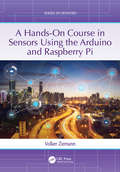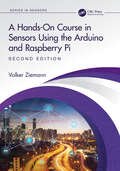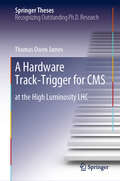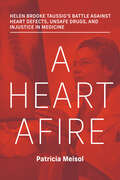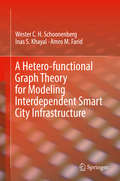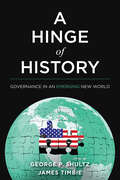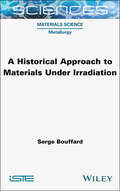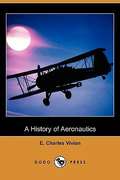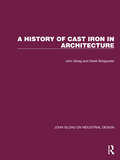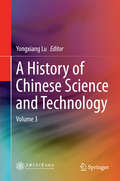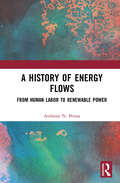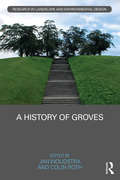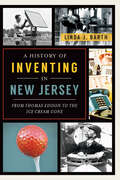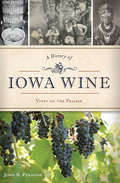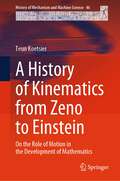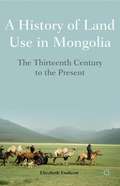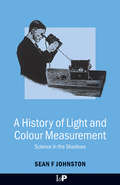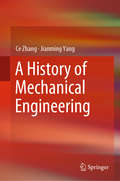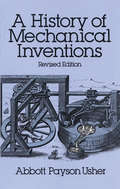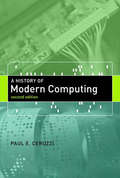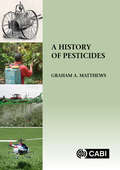- Table View
- List View
A Hands-On Course in Sensors Using the Arduino and Raspberry Pi (Series in Sensors)
by Volker ZiemannA Hands-On Course in Sensors using the Arduino and Raspberry Pi is the first book to give a practical and wide-ranging account of how to interface sensors and actuators with micro-controllers, Raspberry Pi and other control systems. The author describes the progression of raw signals through conditioning stages, digitization, data storage and presentation. <P><P>The collection, processing, and understanding of sensor data plays a central role in industrial and scientific activities. This book builds simplified models of large industrial or scientific installations that contain hardware and other building blocks, including services for databases, web servers, control systems, and messaging brokers. A range of case studies are included within the book, including a weather station, geophones, a water-colour monitor, capacitance measurement, the profile of laser beam, and a remote-controlled and fire-seeking robot <P><P>This book is suitable for advanced undergraduate and graduate students taking hands-on laboratory courses in physics and engineering. Hobbyists in robotics clubs and other enthusiasts will also find this book of interest. <P><P>Features: <li>Includes practical, hands-on exercises that can be conducted in student labs, or even at home <li>Covers the latest software and hardware, and all code featured in examples is discussed in detail <li>All steps are illustrated with practical examples and case studies to enhance learning
A Hands-On Course in Sensors Using the Arduino and Raspberry Pi (Series in Sensors)
by Volker ZiemannA Hands-On Course in Sensors Using the Arduino and Raspberry Pi is the first book to give a practical and wide-ranging account of how to interface sensors and actuators with micro-controllers, Raspberry Pi and other control systems. The author describes the progression of raw signals through conditioning stages, digitization, data storage and presentation. The collection, processing, and understanding of sensor data plays a central role in industrial and scientific activities. This book builds simplified models of large industrial or scientific installations that contain hardware and other building blocks, including services for databases, web servers, control systems, and messaging brokers. A range of case studies are included within the book, including a weather station, ground-vibration measurements, impedance measurements, interfacing medical sensors to web browsers, the profile of a laser beam, and a remote-controlled and fire-seeking robot. This second edition has been updated throughout to reflect new hardware and software releases since the book was first published. Newly added features include the ESP32 microcontroller, several environmental and medical sensors, actuators for signal generation, as well as a chapter on web sockets; all illustrated in new case studies. This book is suitable for advanced undergraduate and graduate students taking hands-on laboratory courses in physics and engineering. Hobbyists in robotics clubs and other enthusiasts will also find this book of interest. Features: Includes practical, hands-on exercises that can be conducted in student labs, or even at home Covers the latest software and hardware, and all code featured in examples is discussed in detail All steps are illustrated with practical examples and case studies to enhance learning https://github.com/volkziem/HandsOnSensors2ed Volker Ziemann obtained his PhD in accelerator physics from Dortmund University in 1990. After post-doctoral positions in Stanford at SLAC and in Geneva at CERN, where he worked on the design of the LHC, in 1995 he moved to Uppsala where he worked at the electron-cooler storage ring CELSIUS. In 2005 he moved to the physics department where he has since taught physics. He was responsible for several accelerator physics projects at CERN, DESY and XFEL. In 2014 he received the Thuréus prize from the Royal Society of Sciences in Uppsala.
A Hardware Track-Trigger for CMS: at the High Luminosity LHC (Springer Theses)
by Thomas Owen JamesThe work described in this PhD thesis is a study of a real implementation of a track-finder system which could provide reconstructed high transverse momentum tracks to the first-level trigger of the High Luminosity LHC upgrade of the CMS experiment. This is vital for the future success of CMS, since otherwise it will be impossible to achieve the trigger selectivity needed to contain the very high event rates. The unique and extremely challenging requirement of the system is to utilise the enormous volume of tracker data within a few microseconds to arrive at a trigger decision.The track-finder demonstrator described proved unequivocally, using existing hardware, that a real-time track-finder could be built using present-generation FPGA-based technology which would meet the latency and performance requirements of the future tracker. This means that more advanced hardware customised for the new CMS tracker should be even more capable, and will deliver very significant gains for the future physics returns from the LHC.
A Heart Afire: Helen Brooke Taussig's Battle Against Heart Defects, Unsafe Drugs, and Injustice in Medicine
by Patricia MeisolA deeply compelling biography of the pioneering children�s heart doctor Helen Taussig, who helped start heart surgery and became a global force against preventable suffering.
A Hetero-functional Graph Theory for Modeling Interdependent Smart City Infrastructure
by Amro M. Farid Inas S. Khayal Wester C. SchoonenbergCities have always played a prominent role in the prosperity of civilization. Indeed, every great civilization we can think of is associated with the prominence of one or more thriving cities. And so understanding cities -- their inhabitants, their institutions, their infrastructure -- what they are and how they work independently and together -- is of fundamental importance to our collective growth as a human civilization. Furthermore, the 21st century “smart” city, as a result global climate change and large-scale urbanization, will emerge as a societal grand challenge. This book focuses on the role of interdependent infrastructure systems in such smart cities especially as it relates to timely and poignant questions about resilience and sustainability. In particular, the goal of this book is to present, in one volume, a consistent Hetero-Functional Graph Theoretic (HFGT) treatment of interdependent smart city infrastructures as an overarching application domain of engineering systems. This work may be contrasted to the growing literature on multi-layer networks, which despite significant theoretical advances in recent years, has modeling limitations that prevent their real-world application to interdependent smart city infrastructures of arbitrary topology. In contrast, this book demonstrates that HFGT can be applied extensibly to an arbitrary number of arbitrarily connected topologies of interdependent smart city infrastructures. It also integrates, for the first time, all six matrices of HFGT in a single system adjacency matrix. The book makes every effort to be accessible to a broad audience of infrastructure system practitioners and researchers (e.g. electric power system planners, transportation engineers, and hydrologists, etc.). Consequently, the book has extensively visualized the graph theoretic concepts for greater intuition and clarity. Nevertheless, the book does require a common methodological base of its readers and directs itself to the Model-Based Systems Engineering (MBSE) community and the Network Science Community (NSC). To the MBSE community, we hope that HFGT will be accepted as a quantification of many of the structural concepts found in model-based systems engineering languages like SysML. To the NSC, we hope to present a new view as how to construct graphs with fundamentally different meaning and insight. Finally, it is our hope that HFGT serves to overcome many of the theoretical and modeling limitations that have hindered our ability to systematically understand the structure and function of smart cities.
A Hinge of History: Governance in an Emerging New World
by George P. Shultz James TimbieThe world is at an inflection point. Advancing technologies are creating new opportunities and challenges. Great demographic changes are occurring rapidly, with significant consequences. Governance everywhere is in disarray. A new world is emerging.These are some of the key insights to emerge from a series of interdisciplinary roundtables and global expert contributions hosted by the Hoover Institution. In these pages, George P. Shultz and James Timbie examine a range of issues shaping our present and future, region by region.Concrete proposals address migration, reversing the decline of K–12 education, updating the social safety net, maintaining economic productivity, protecting our democratic processes, improving national security, and more. Meeting these transformational challenges will require international cooperation, constructive engagement, and strong governance. The United States is well positioned to ride this wave of change—and lead other nations in doing the same.
A Historical Approach to Materials Under Irradiation (ISTE Invoiced)
by Serge BouffardResearchers and students have not yet had access to a book which would enable them to trace the origins of the concepts that explain the behavior of materials under irradiation. This book fills the gap. As far back as antiquity, the notions of purity and disorder have been evoked to explain the different properties of materials. It was geologists who developed the subject in the 19th century. Then, with the discovery of X-rays and radioactivity, disorder in materials became the domain of physicists and chemists. The first observations focused on the color changes of ionic crystals, then gradually all the techniques for characterising materials were used. However, questions about the resistance of the components of the first atomic piles to irradiation led to the development of irradiation studies. This book describes the historical approaches to particle transport and defect creation mechanisms. Several chapters detail the history of irradiation of different types of materials: metals, semiconductors, iono-covalent insulators, polymers and radiolysis of water. The final two chapters deal with irradiation tools and applications.
A History and Philosophy of Fluid Mechanics (Dover Books on Aeronautical Engineering)
by G. A. TokatyThrough the centuries, the intricacies of fluid mechanics -- the study of the laws of motion and fluids in motion -- have occupied many of history's greatest minds. In this pioneering account, a distinguished aeronautical scientist presents a history of fluid mechanics focusing on the achievements of the pioneering scientists and thinkers whose inspirations and experiments lay behind the evolution of such disparate devices as irrigation lifts, ocean liners, windmills, fireworks and spacecraft.The author first presents the basics of fluid mechanics, then explores the advances made through the work of such gifted thinkers as Plato, Aristotle, da Vinci, Galileo, Pascal, Newton, Bernoulli, Euler, Lagrange, Ernst Mach and other scientists of the 20th century. Especially important for its illuminating comparison of the development of fluid mechanics in the former Soviet Union with that in the West, the book concludes with studies of transsonic compressibility and aerodynamics, supersonic fluid mechanics, hypersonic gas dynamics and the universal matter-energy continuity. Professor G. A. Tokaty has headed the prestigious Aeronautical Research Laboratory at the Zhukovsky Academy of Aeronautics in Moscow, and has taught at the University of California, Los Angeles. He is Emeritus Professor of Aeronautics and Space Technology, The City University, London.
A History of Cast Iron in Architecture (John Gloag On Industrial Design Ser.)
by John Gloag Derek BridgwaterOriginally published in 1948, A History of Cast Iron in Architecture is a comprehensive history of the part that has been played by cast iron in architecture and the allied arts in Britain. Any history of the rise and development of the iron-founding industry becomes virtually a history of the First Industrial Revolution. Examining the use of cast iron by builders and architects from late medieval times to the middle of the 20th Century the authors have also recorded a miniature history of British Industry. The introduction throws light on the early developments of iron-founding. The main sections of the book describe the rise and expansion of the cast-iron industry and its gradually increasing significance in architecture from 1650 to 1945. There are over 500 illustrations.
A History of Chinese Science and Technology: Volume 3
by Yongxiang LuA History of Chinese Science and Technology (Volumes 1, 2 & 3) presents 44 individual lectures, beginning with Ancient Chinese Science and Technology in the Process of Human Civilizations and an Overview of Chinese Science and Technology, and continuing with in-depth discussions of several issues in the History of Science and the Needham Puzzle, interspersed with topics on Astronomy, Arithmetic, Agriculture and Medicine, The Four Great Inventions, and various technological areas closely related to clothing, food, shelter and transportation. This book is the most authoritative work on the history of Chinese Science and Technology. It is the Winner of the China Book Award, the Shanghai Book Award (1st prize), and the Classical China International Publishing Project (GAPP, General Administration of Press and Publication of China) and offers an essential resource for academic researchers and non-experts alike. It originated with a series of 44 lectures presented to top Chinese leaders, which received very positive feedback. Written by top Chinese scholars in their respective fields from the Institute for the History of Natural Sciences, Chinese Academy of Sciences and many other respected Chinese organizations, the book is intended for scientists, researchers and postgraduate students working in the history of science, philosophy of science and technology, and related disciplines. Yongxiang Lu is a professor, former president and member of the Chinese Academy of Sciences (CAS) and Chinese Academy of Engineering (CAE), and Vice Chairman of the National Congress of China.
A History of Energy Flows: From Human Labor to Renewable Power
by Anthony N. PennaThis book presents a global and historical perspective of energy flows during the last millennium. The search for sustainable energy is a key issue dominating today’s energy regime. This book details the historical evolution of energy, following the overlapping and slow flowing transitions from one regime to another. In doing so it seeks to provide insight into future energy transitions and the means of utilizing sustainable energy sources to reduce humanity’s fossil fuel footprint. The book begins with an examination of the earliest and most basic forms of energy use, namely, that of humans metabolizing food in order to work, with the first transition following the domestication and breeding of horses and other animals. The book also examines energy sources key to development during the industrialization and mechanization, such as wood and coal, as well as more recent sources, such as crude oil and nuclear energy. The book then assesses energy flows that are at the forefront of sustainability, by examining green sources, such as solar, wind power and hydropower. While it is easy to see energy flows in terms of “revolutions,” transitions have taken centuries to evolve, and transitions are never fully global, as, for example, wood remains the primary fuel source for cooking in much of the developing world. This book not only demonstrates the longevity of energy transitions but also discusses the possibility for reducing transition times when technological developments provide inexpensive and safe energy sources that can reduce the dependency on fossil fuels. This book will be of great interest to students and scholars of energy transitions, sustainable energy and environmental and energy history.
A History of Groves (Routledge Research in Landscape and Environmental Design)
by Jan Woudstra Colin RothThe grove, a grouping of trees, intentionally cultivated or found growing wild, has a long diverse history entwined with human settlement, rural practices and the culture and politics of cities. A grove can be a memorial, a place of learning, a site of poetic retreat and philosophy or political encampment, a public park or theatre, a place of hidden pleasures, a symbol of a vanished forest ecology, or a place of gods or other spirits. Yet groves are largely absent from our contemporary vocabulary and rarely included in today’s landscape practice, whether urban or rural. Groves are both literal and metaphorical manifestations, ways of defining spaces and ecologies in our cultural life. Since they can add meaning to urban forms and ecologies and contribute meaningfully to the significance of place, critical examination is long overdue. The editors have taken care to ensure that the text is accessible to the general reader as well as specialists.
A History of Inventing in New Jersey: From Thomas Edison to the Ice Cream Cone
by Linda J. BarthMany Americans are familiar with Thomas Edison's "invention factory" in Menlo Park, where he patented the phonograph, the light bulb and more than one thousand other items. Yet many other ideas have grown in the Garden State, too--New Jerseyans brought sound and music to movies and built the very first drive-in theater. In addition to the first cultivated blueberry, tasty treats like ice cream cones and M&Ms are also Jersey natives. Iconic aspects of American life, like the batting cage, catcher's mask and even professional baseball itself, started in New Jersey. Life would be a lot harder without the vacuum cleaner, plastic and Band-Aids, and many important advances in medicine and surgery were also developed here. Join author Linda Barth as she explores groundbreaking, useful, fun and even silly inventions and their New Jersey roots.
A History of Iowa Wine: Vines on the Prairie (American Palate)
by John N. PeragineIowa has a history with grapevines that goes back more than a century. New York lawyer Hiram Barney obtained a tract of land in southeast Iowa as part of the Half-Breed program following the American Indian Wars and created the White Elk Winery. German settlers in Amana tended community vineyards for communal wines. Before Prohibition, the Council Bluffs Grape Growers Association grew grapes and shipped them eastward by the ton. In the early 1900s, the state was among the nation's top producers of grapes. Pesticides, weather and government subsidies ended the time of the vines of the prairie until their recent return. Author John N. Peragine details the rise, fall and resurgence of the industry in the Hawkeye State.
A History of Italian Wine: Culture, Economics, and Environment in the Nineteenth through Twenty-First Centuries
by Paolo Tedeschi Manuel Vaquero Piñeiro Luciano MaffiThis book analyzes the evolution of Italian viticulture and winemaking from the 1860s to the new Millennium. During this period the Italian wine sector experienced a profound modernization, renovating itself and adapting its products to international trends, progressively building the current excellent reputation of Italian wine in the world market.Using unpublished sources and a vast bibliography, authors highlight the main factors favoring this evolution: public institutional support to viticulture; the birth and the growth of Italian wine entrepreneurship; the improvement in quality of the winemaking processes; the increasing relevance of viticulture and winemaking in Italian agricultural production and export; and the emergence of wine as a cultural product.
A History of Kinematics from Zeno to Einstein: On the Role of Motion in the Development of Mathematics (History of Mechanism and Machine Science #46)
by Teun KoetsierThis book covers the history of kinematics from the Greeks to the 20th century. It shows that the subject has its roots in geometry, mechanics and mechanical engineering and how it became in the 19th century a coherent field of research, for which Ampère coined the name kinematics. The story starts with the important Greek tradition of solving construction problems by means of kinematically defined curves and the use of kinematical models in Greek astronomy. As a result in 17th century mathematics motion played a crucial role as well, and the book pays ample attention to it. It is also discussed how the concept of instantaneous velocity, unknown to the Greeks, etc was introduced in the late Middle Ages and how in the 18th century, when classical mechanics was formed, kinematical theorems concerning the distribution of velocity in a solid body moving in space were proved. The book shows that in the 19th century, against the background of the industrial revolution, the theory of machines and thus the kinematics of mechanisms received a great deal of attention. In the final analysis, this led to the birth of the discipline.
A History of Land Use in Mongolia
by Elizabeth EndicottAn illustrated history of the pastoral nomadic way of life in Mongolia, this book examines the many challenges that Mongolian herders continue to face in the struggle over natural resources in the post-socialist free market era.
A History of Light and Colour Measurement: Science in the Shadows
by Sean F. Johnston2003 Paul Bunge Prize of the Hans R. Jenemann Foundation for the History of Scientific InstrumentsJudging the brightness and color of light has long been contentious. Alternately described as impossible and routine, it was beset by problems both technical and social. How trustworthy could such measurements be? Was the best standard of inten
A History of Mechanical Engineering
by Jianming Yang Ce ZhangThis book explores the history of mechanical engineering since the Bronze Age. Focusing on machinery inventions and the development of mechanical technology, it also discusses the machinery industry and modern mechanical education. The evolution of machinery is divided into three stages: Ancient (before the European Renaissance), Modern (mainly including the two Industrial Revolutions) and Contemporary (since the Revolution in Physics, especially post Second World War). The book not only clarifies the development of mechanical engineering, but also reveals the driving forces behind it – e.g. the economy, national defense and human scientific research activities – to highlight the links between technology and society; mechanical engineering and the natural sciences; and mechanical engineering and related technological areas.Though mainly intended as a textbook or supplemental reading for graduate students, the book also offers a unique resource for researchers and engineers in mechanical engineering who wish to broaden their horizons.
A History of Mechanical Inventions: Revised Edition
by Abbott Payson Usher"The book is without peer in its field." -- American ScientistIn this completely revised and enlarged edition of a classic work in the history of technology, a noted scholar explores the importance of technological innovation in the cultural and economic history of the West.Following an introductory discussion of the place of technology in economic history, the author offers a penetrating historical analysis of social change. Within this context he develops a theory of invention based on Gestalt psychology and a concept of social evolution as continuous development from antiquity to the present. Emphasis is placed on the role of economic forces in the development of technology, with scientific concepts also playing an important role in bringing about change.The latter part of the book focuses on the production and control of power in general, and in particular on a number of important operative mechanisms. Thus we read thought-provoking accounts of the technology of textile manufacture from primitive times, of water wheels and windmills, water clocks, and mechanical clocks, and the work of Leonardo da Vinci. The development of printing is carefully studied, not only for its intrinsic interest, but because of its importance for the history of science. Other topics include the production and application of power (1500-1830), machine tools and quantity production, the production and distribution of power since 1832, and the role of Asia Minor as a source of techniques which dominated the Middle Ages and the modern period as well.Thoroughly researched and cogently reasoned, A History of Mechanical Inventions belongs in the library of anyone interested in the history of science and invention, as well as the relationship of technology to economic and social history."Throughout the book there is constant proof of the author's wide learning and varied intellectual interests." -- The New York Times
A History of Modern Computing, second edition (History of Computing)
by Paul E. CeruzziFrom the first digital computer to the dot-com crash—a story of individuals, institutions, and the forces that led to a series of dramatic transformations.This engaging history covers modern computing from the development of the first electronic digital computer through the dot-com crash. The author concentrates on five key moments of transition: the transformation of the computer in the late 1940s from a specialized scientific instrument to a commercial product; the emergence of small systems in the late 1960s; the beginning of personal computing in the 1970s; the spread of networking after 1985; and, in a chapter written for this edition, the period 1995-2001. The new material focuses on the Microsoft antitrust suit, the rise and fall of the dot-coms, and the advent of open source software, particularly Linux. Within the chronological narrative, the book traces several overlapping threads: the evolution of the computer's internal design; the effect of economic trends and the Cold War; the long-term role of IBM as a player and as a target for upstart entrepreneurs; the growth of software from a hidden element to a major character in the story of computing; and the recurring issue of the place of information and computing in a democratic society. The focus is on the United States (though Europe and Japan enter the story at crucial points), on computing per se rather than on applications such as artificial intelligence, and on systems that were sold commercially and installed in quantities.
A History of Pesticides
by Graham MatthewsIn this fascinating book, Graham Matthews takes the reader through the history of the development and use of chemicals for control of pests, weeds, and vectors of disease. Prior to 1900 only a few chemicals had been employed as pesticides but in the early 1940s, as the Second World War raged, the insecticide DDT and the herbicide 2-4-D were developed. These changed everything. Since then, farmers have been using a growing list of insecticides, herbicides and fungicides to protect their crops. Their use has undoubtedly led to significant gains in agricultural production and reduction in disease transmission, but also to major problems: health concerns for both users of pesticides and the general public, the emergence of resistance in pest populations, and environmental problems. The book examines the development of legislation designed to control and restrict the use of pesticides, the emergence of Integrated Pest Management (IPM) and the use of biological control agents as part of policy to protect the environment and encourage the sustainable use of pesticides. Finally, the use of new technologies in pest control are discussed including the use of genetic modification, targeted pesticide application and use of drones, alongside basic requirements for IPM such as crop rotations, close seasons and adoption of plant varieties with resistance to pests and diseases.
A History of Pesticides
by Graham MatthewsIn this fascinating book, Graham Matthews takes the reader through the history of the development and use of chemicals for control of pests, weeds, and vectors of disease and then discusses their future.
A History of Place in the Digital Age (Digital Research in the Arts and Humanities)
by Stuart DunnA History of Place in the Digital Age explores the history and impact of Geographic Information Systems (GIS) and related digital mapping technologies in humanities research. Providing a historical and methodological discussion of place in the most important primary materials which make up the human record, including text and artefacts, the book explains how these materials frame, form and communicate location in the age of the internet. This leads in to a discussion of how the World Wide Web distorts and skews place, amplifying some voices and reducing others. Drawing on several connected case studies from the early modern period to the present day, the spatial writings of early modern antiquarians are explored, as are the roots of approaches to place in archaeology and philosophy. This forms the basis for a review of place online, through the complex history of the invention of the internet, in to the age of the interactive web and social media. By doing so, the book explores the key themes of spatial power and representation which these technologies frame. A History of Place in the Digital Age will be of interest to scholars, students and practitioners in a variety of humanities disciplines with an interest in understanding how technology can help them undertake research on spatial themes. It will be of interest as primary work to historians of technology, media and communications.
